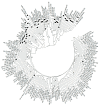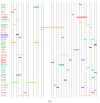Experience in Diagnostic of HIV Drug Resistance in the Mekong Delta Region, Vietnam: A Comparative Analysis Before and After the COVID-19 Pandemic
- PMID: 40428272
- PMCID: PMC12109980
- DOI: 10.3390/diagnostics15101279
Experience in Diagnostic of HIV Drug Resistance in the Mekong Delta Region, Vietnam: A Comparative Analysis Before and After the COVID-19 Pandemic
Abstract
Background: Vietnam has made significant strides in reducing the prevalence of HIV infection and achievements in its antiretroviral treatment program. However, the COVID-19 pandemic and financial challenges in the healthcare system have posed significant obstacles to maintaining effective HIV treatment and monitoring, particularly among vulnerable populations. This study aims to evaluate the situation of HIV drug resistance among patients who have experienced treatment failure in the Mekong Delta region and to compare data from 2019 to 2022. Methods: The study material was blood plasma samples from HIV-infected individuals with ART failure: 316 collected in 2019 and 326 collected in 2022. HIV-1 genotyping and mutation detection were performed based on an analysis of the nucleotide sequences of the Pol gene region. A total of 116 HIV-infected individuals with virological failure in 2019 and 2022 were assessed for HIV drug resistance. Results: The study revealed a high proportion of participants with viral loads exceeding 1000 copies/mL, significantly increasing from 12.0% in 2019 to 23.9% in 2022 (OR = 2.3; p = 0.0001). HIV drug resistance mutations were detected in 84.21% of cases in 2019 and 92.59% in 2022. The prevalence of concurrent resistance to NRTIs and NNRTIs was 37.5% and 30.13% in 2019 and 2022, respectively. There was a statistically significant decrease in NNRTI resistance (OR = 0.32, χ2 = 5.43, p < 0.05). In contrast, multi-drug resistance to protease inhibitors rose from 18.52% to 45.21% (φ* = 0.00403, p < 0.05). Triple-class resistance was identified only in 2022 (17.81%). The most common mutations included M184I/V, D67N, K103N, Y181C, and V82A/S/T, with D67N rising significantly from 3.13% to 21.92%. The predominant subtype was CRF01_AE. Conclusion: A high prevalence of viral non-suppression and HIV drug resistance was observed among patients in the Mekong Delta region, particularly after the onset of the COVID-19 pandemic. Our study highlights the ongoing challenges that the HIV/AIDS treatment program in Vietnam must address in the post-pandemic period to sustain its success and achieve the goals of the country's HIV prevention strategies.
Keywords: HIV drug resistance mutation; HIV-1; NNRTI; NRTI; PI; Vietnam; virological failure.
Conflict of interest statement
The authors declare no conflicts of interest.
Figures










References
-
- UNAIDS. The Urgency of Now: AIDS at a Crossroads. Geneva: Joint United Nations Programme on HIV/AIDS. 2024. [(accessed on 29 February 2024)]. Available online: https://www.unaids.org/sites/default/files/media_asset/2024-unaids-globa....
-
- de Mendoza C. Hot News: HIV Epidemics—Current Burden and Future Prospects. AIDS Rev. 2017;19:239. - PubMed
-
- Gupta R.K., Jordan M.R., Sultan B.J., Hill A., Davis D.H., Gregson J., Sawyer A.W., Hamers R.L., Ndembi N., Pillay D., et al. Global trends in antiretroviral resistance in treatment-naive individuals with HIV after rollout of antiretroviral treatment in resource-limited settings: A global collaborative study and meta-regression analysis. Lancet. 2012;380:1250–1258. doi: 10.1016/S0140-6736(12)61038-1. - DOI - PMC - PubMed
-
- Pasquet A., Messou E., Gabillard D., Minga A., Depoulosky A., Deuffic-Burban S., Losina E., Freedberg K.A., Danel C., Anglaret X., et al. Impact of drug stock-outs on death and retention to care among HIV-infected patients on combination antiretroviral therapy in Abidjan. Cote d’Ivoire PLoS ONE. 2010;5:e13414. doi: 10.1371/journal.pone.0013414. - DOI - PMC - PubMed
LinkOut - more resources
Full Text Sources
Research Materials
Miscellaneous

